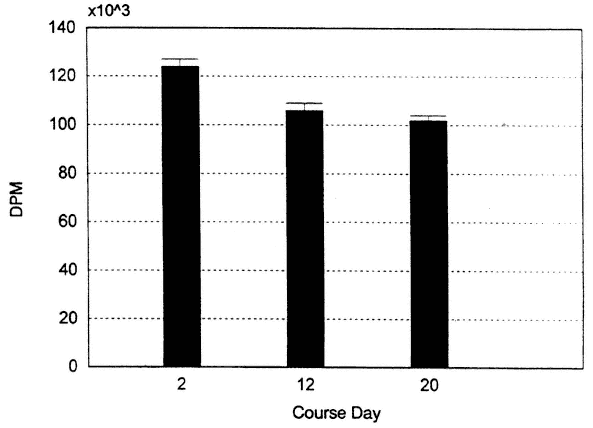5
Physiological and Immunological Impact of U.S. Army Special Operations Training A Model for the Assessment of Nutritional Intervention Effects on Temporary Immunosuppression
LTC Ronald L. Shippee1
Introduction
Historically, nutritional adequacy of operational (field) rations for soldiers has been defined by the ability of the rations to sustain blood levels of a particular nutrient or metabolite of the nutrient. Adequacy of certain vitamins and minerals has further been defined by the functional assessment of blood cell activity of selected enzymes. Based on these accepted criteria, the current military operational ration (Meal, Ready-to-Eat, MRE) has met the assessment for nutritional adequacy in a number of varied field settings over the past 10 years. Even when consumed at a rate of one MRE per day for periods of up to 10 days, the MRE appeared to supply adequate micronutrient nutrition in U.S. Army Ranger students (Moore et al., 1992).
Many reports in the scientific literature are causing nutritional scientists to question the traditional assessments of nutritional adequacy. The current U.S. Recommended Dietary Allowances are in the process of being revised and updated; the Dietary Reference Intakes, as they will be known, will present recommended adequate levels of the nutrients for selected populations. The publicity concerning the recent research on the effect of perinatal folic acid supplementation on the incidence of congenital neural tube defects is a good example of a research finding that challenges the traditional view of nutrient adequacy.
One area of active research of particular concern to this readership involves assessment of nutritional adequacy based on immune responses. This is of particular importance to military operations during periods of extreme physical and psychological stress. Considerable interest in the exercise physiology and nutrition literature during the past 5 years focuses on the interaction of nutrition and susceptibility to infection in athletes training for competition. Although close analogies can be drawn between training for an athletic event and military combat training, some important differences need to be addressed. While an athlete is usually well rested and fed a diet specific to his or her sport and nutritional needs, individuals involved in combat training are often sleep deprived and fed ''one-size-fits-all'' military operational rations. Another important difference is that soldiers often suffer abrasions and cuts, which increases the chance for opportunistic infection.
Special Operations training offers the unique opportunity to determine the extent of immunological perturbations during military training. Furthermore, the structured nature of the training schools provides the opportunity to conduct controlled research studies designed to screen nutritional strategies that may be effective in sustaining immune responses during the stress of combat training. During the past 4 years, a number of field studies related to this issue have been conducted in collaboration with the Ranger Training Brigade (RTB), Fort Benning, Georgia, and the Special Warfare Training Center, Fort Bragg, North Carolina.
Research Objectives
The research conducted in these locations has been guided by two primary research objectives:
- Combat training by its nature often involves risk of injury. The leadership must always balance training objectives with many safety issues. The primary goal of this research has been to provide physiological data that the commanders can use to develop guidelines for such issues as sleep deprivation, food restriction, and exposure to temperature extremes during strenuous physical training.
- Access to young, healthy soldiers who are experiencing temporary alterations in immune responses has important implications for both military and civilian applications. The military relevance of this issue is obvious, considering that during all the major military conflicts in which the U.S. Armed Forces have been involved in modern history, nonbattle injury and infection account for far more casualties than those inflicted by enemy action (Palinkas, 1988; Seay, 1995). Most of the information concerning the interaction between nutrition and immune responses has been developed from research with individuals recovering from severe trauma injuries. Results from nutritional interventions during periods of combat training stress have the potential for contributing important scientific data to the field of nutritional immunology. This line of research will ultimately lead to the development of nutritional strategies designed to sustain host defense mechanisms during periods of extreme physiological and physical stress.
-
Results
U.S. Army Ranger training and the Special Forces Assessment and Selection (SFAS) course are physically and psychologically demanding programs used by the U.S. Army to screen male officers and enlisted soldiers for entry into U.S. Army Special Operations units. Since the summer of 1992, a number of studies have been conducted with these Special Operations schools through collaborative research among the U.S. Army Medical Research and Materiel Command (USAMRMC), the Soldier System Command, U.S. Department of Agriculture, and Ross Products Division, Abbott Laboratories (ROSS).
Studies Involving Ranger Training
The RTB, Fort Benning, Georgia, conducts Ranger training continuously during the year, with classes starting approximately every 30 days. Until recently, Ranger training involved four, 2-wk phases conducted at geographically diverse training sites: Phase 1, Fort Benning, Georgia; Phase 2 (desert phase), Fort Bliss, Texas; Phase 3 (mountain phase), Dahlonega, Georgia; Phase 4, Eglin Air Force Base, Florida. Recently, the desert phase was eliminated, leaving three phases consisting of approximately 21 days each. At the end of each phase, soldiers are involved in 7- to 10-d field training exercises (FTX). Usually the soldiers conduct continuous operations during the FTX portions of the training and are not allowed to return to the barracks areas of the camps.
The severity of the Ranger training and episodic increases in accidents and infection resulted in two medical research studies during the mid-1960s and 1970s (Consolazio et al., 1966; Johnson et al., 1976). During the 1990–1991
training year, an unusually high number of Streptococcal pneumonia infections prompted a request from the RTB to the USAMRMC. This request resulted in two independent research studies conducted in 1991 by research teams from the Walter Reed Army Institute of Research and the U.S. Army Research Institute of Environmental Medicine (USARIEM). Based on the findings of these two studies, an additional study by USARIEM was conducted in the summer of 1992.
The salient results of the USARIEM study (Ranger I, RGR-I) are shown in Figures 5-1 through 5-10. The result of the energy expenditure (Figure 5-1) and intake (Figure 5-2) assessment was an average daily negative energy balance of -1,203 kcal (Figure 5-3). The feeding plan during the summer months in which the 1991 studies were conducted supplied one MRE during the FTX portions of the training. The impact of this negative energy balance was a 14 percent decrease in body weight (Figure 5-4) and a decrease in the average body fat from 16 percent to 5 percent (Figure 5-5). The impact of the severity of the training on physiological response is further reflected in changes in endocrine profiles. Figures 5-6 and 5-7 show the changes in circulating levels of testosterone and triiodothyronine (T3). Testosterone levels were suppressed below castration levels during the last three phases of the training.
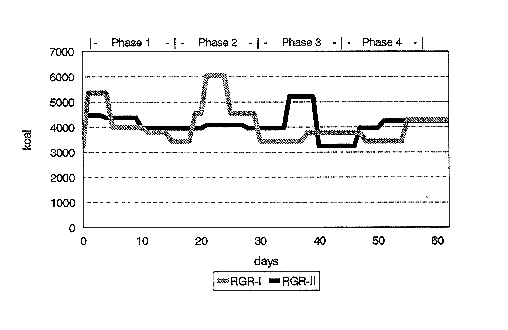
FIGURE 5-1
Energy expenditure during the Ranger I and Ranger II studies as measured by the doubly labeled water method.
Assessment of the impact of the training on immune responses was primarily determined using an in vitro proliferation assay. Details of the methodology used to perform the proliferation assay are outlined in Moore et al. (1992). Blood drawn at the various phases of training was transported from the training camps to the laboratory. In a sterile cell culture hood, the vacuum tube was uncapped, and a small portion of the blood was removed and diluted with cell culture medium. The diluted blood was pipetted into cell culture wells, followed by a volume of medium containing various compounds (mitogen) that are commonly used to stimulate white blood cells (lymphocytes) to proliferate in culture conditions. After 2 days, the culture cells were pulsed with a radioactively labeled nucleic acid. Over the next 24 hours, cells that were replicating took up the radioactive label and incorporated the nucleic acid into their DNA. After a total of 72 hours in culture, the cells were harvested with equipment that lyses the cells and traps both the labeled and unlabeled DNA on a small paper disk. This disk was then placed in a vial for subsequent determination of the amount of radiation it contained. The higher the radioactivity, the greater the cells' capacity to proliferate.
Data from the cells stimulated by the T-lymphocyte-stimulating mitogen (phytohemagglutinin) for RGR-I are shown in Figure 5-8. The immune response was significantly suppressed at the end of both the mountain and swamp phases of the training when compared with the other time points. The biological

FIGURE 5-8
Percent change in peripheral blood lymphocyte proliferation during the Ranger I and Ranger II studies.
actions of T-lymphocytes are diverse and range from direct killing of invading pathogens to controlling the response of other lymphocyte cell types such as antibody production by B-lymphocytes. The fact that the T-lymphocyte proliferation response, or cellular response , was so adversely affected by the training was a very important finding of the RGR-I study.
Results from the study showing low body fat, altered endocrine patterns, perturbations in immune function, and undernutrition raised serious concern with a number of reviewers of the data. The National Academy of Sciences' Committee on Military Nutrition Research (CMNR) was particularly concerned with the impact of these altered physiological responses on thermogenic regulation of soldiers in response to cold exposure.
The final recommendation made to the RTB by the CMNR was to increase Rangers' ration intake during the FTX portions of the training such that no more than 10 percent of body weight was lost. This translated into an increase of 15 percent in food intake during Ranger training. The RTB agreed with this recommendation, and a second (follow-up) study, Ranger II (RGR-II), was conducted during the summer of 1992. To achieve the 15 percent increase in caloric intake, the Long Life Ration Packet (LLRP) was used instead of the MRE.
The salient findings from this study are summarized in Figures 5-1 through 5-10. The increased caloric intake of Rangers in training (in RGR-II) decreased the average daily negative energy balance of -1,203 kcal during RGR-I to -847 kcal (Figure 5-3). This resulted in an average 12 percent body weight loss and a final average percent body fat of 8 percent (Figures 5-4 and 5-9). The physiological impact of the increased caloric intake was also reflected in blood testosterone and T3 concentrations (Figures 5-10 and 5-11).
The infection rates during RGR-I for the desert, mountain, and swamp phases of training were 8, 25, and 24 percent, respectively, while the infection rates for the same phases during the caloric intervention study (RGR-II) were 12, 8, and 2 percent, respectively. This decrease in infection is supported by the proliferation data (Figure 5-8). However, although the cellular response was less suppressed during RGR-II when compared with RGR-I, the suppression during RGR-II was still considered clinically significant.
The research resulted in two significant changes to Ranger training. First, the RTB changed the MRE distribution to three meals per (every) 2 days, with additional supplementation during the winter classes. Second, the data were used by the RTB to support the request for additional medical support. This resulted in the permanent assignment of a physician's assistant at each of the three training camps.
It is impossible to determine by comparing data from RGR-I with that from RGR-II if the apparent benefit of the intervention with respect to immune responses was due to increased energy or specific nutrient(s) contained in the increased intake. The USARIEM research team attempted to answer this

FIGURE 5-11
Serum triiodothyronine concentration changes during the Ranger II study.
question in a study conducted with volunteers from the Ranger training cadre stationed at Camp Merrill, Dahlonega, Georgia (Montain et al., 1995). The study's main purpose was to determine the effect of carbohydrate-electrolyte beverage on physical performance during 3 days of intense activity performing military-relevant tasks. Concurrently, the effect of energy intake on lymphocyte proliferation was tested. The total energy intake for the 3 days was 7,846 ± 1,460 and 5,312 ± 1,228 for the beverage test group and water control group, respectively. Energy intake from field rations was similar for each group. However, no significant difference in lymphocyte proliferation was measured between the two groups.
Given these findings and some favorable results from specific nutrient intervention studies conducted with the SFAS as described below, USARIEM approached the RTB in February 1996 concerning possible nutrient intervention studies of Rangers in training. Encouraged by the data, the RTB recommended that a research protocol be developed. Shortly after this meeting four Ranger students died of hypothermia during the swamp phase of Ranger training.
In a March 1996 meeting of the RTB and USARIEM, it was decided that a comprehensive research study would be conducted to reevaluate the physiological impact of Ranger training. The course had been reduced to three phases and the training events changed in response to the February tragedy.
The study was conducted in two parts (Young and Shippee, 1995). During November 1995, the effect of cold exposure was determined in 15 volunteers immediately after they had completed the swamp phase of Ranger training. The second part involved monitoring energy balance, body composition, nutritional status, and immune responses during each phase of the training. This part of the study was completed on April 7, 1996, and the data are being analyzed. From data on body composition and body weight changes of the 39 volunteers that remained in the study, some preliminary conclusions can be drawn. Percentage body fat decreased from a baseline of 15.3 percent down to 10.0 percent at the end of the 62 days of training. A net change in body weight of -7 lbs (3 kg) provides an estimate of energy balance of approximately -415 kcal/d. This is considerably less than the energy deficit shown for RGR-I and RGR-II and reflects the changes instituted by the RTB since February 1995.
Studies Involving Special Forces Assessment and Selection Training
Shortly after completing the RGR-II study, USARIEM received a request from the First Special Warfare Training Group to determine the physiological impact of SFAS training. The SFAS is a 21-d, physically and psychologically demanding course. Although food deprivation is not used as an overt training stressor, self-reported weight losses of between 10 and 15 lbs (4.5 and 6.8 kg) raised concern among the cadre.
The first study of SFAS (SFAS-I) was conducted in the summer of 1993 using a research design and methodology similar to that used in the RGR studies. The data are summarized in Figures 5-12 through 5-15. Although the volunteers were provided a mix of A rations and MREs 3 times per day, there was an average negative energy balance of 1,379 kcal/d (Figure 5-12). This level of negative energy balance resulted in an average weight loss of 7 lbs (3 kg) (Figure 5-13) and a change in percent body fat from 15.5 percent at baseline to 11.9 percent at the end of the training (Figure 5-14). Although infection did not contribute significantly to the medical attrition of the volunteers, there was a 23 percent reduction in lymphocyte proliferation (Figure 5-15).
Since this initial study, two additional studies have been conducted involving nutritional intervention. These studies were conducted under a Cooperative Research and Development Agreement (CRDA) with ROSS. The first intervention study used a sports drink-type beverage containing the amino acid glutamine.2 The second intervention used a proprietary-based beverage containing increased levels of selected antioxidants nutrients.
Although glutamine is not normally considered a dietary essential amino acid, evidence in the clinical, scientific literature indicates that dietary supplementation of glutamine is needed to sustain proper gut function and immune responses during recovery from severe trauma (Souba, 1992). Given the results of the work completed thus far with volunteers from Army Special Operations schools, a strong research hypothesis can be developed to support glutamine supplementation under severe training conditions.
Glutamine was given at a rate of 15 g/d for 18 days of the SFAS during the summer months of 1995 (SFAS-II). The lymphocyte proliferation suppression was equal to the level shown in the SFAS-I study; however, there was no significant effect of glutamine supplementation when compared to the glycine content group (Figure 5-16). To expand the assessment of the immune system, a skin test was included (Multi-Test CMI, Connaught Laboratories, Inc., Swiftwater, Pa.) during SFAS-II. The CMI test kit contains a glycerin negative control and seven antigens of culture filtrate from the following microorganisms: tetanus toxoid, diphtheria toxoid, streptococcus, tuberculin, and protease. The test was applied to the vertical forearm of each subject. After 48 hours, the response to each antigen was determined by measuring the diameters of the induration response at each of the eight tine administered sites. The test was administered at the end of the training, and the induration was
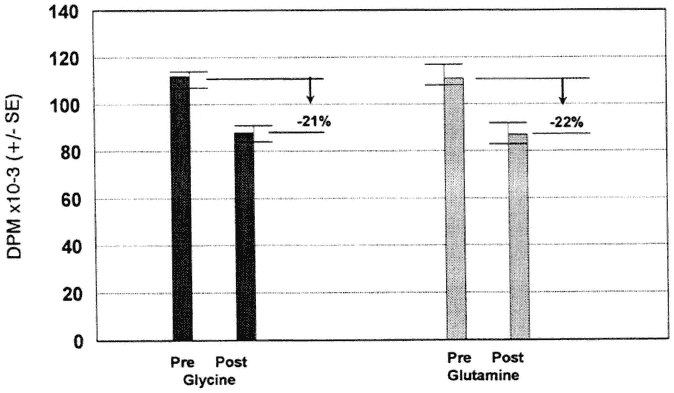
FIGURE 5-16
Peripheral blood lymphocyte proliferation during glutamine supplementation study with the Special Forces Assessment and Selection Course.
measured 24 hours later. Almost twice as many glutamine-supplemented volunteers responded with greater than 10 mm induration to tetanus toxoid when compared with the control group (Table 5-1). This result suggested a beneficial effect of the glutamine treatment. The discrepancies between the results of the two tests of the immune system are difficult to explain on the basis of one study.
During early 1996, an additional intervention study was performed with the SFAS (SFAS-III). This intervention involved a beverage containing four nutrients known to have biological antioxidant properties: vitamin A, vitamin E, vitamin C, and selenium. The beverage was given once a day during the SFAS. Results for the proliferation response and the skin test response to tetanus toxoid are shown in Figures 5-17 and 5-18. The group that received the antioxidant beverage had significantly less suppression of in vitro proliferation than the control group when suppression was expressed as a percentage change from baseline values. While more of the group that received antioxidant beverage gave a positive response to tetanus toxoid, the difference from the control group was not as dramatic as the responses shown in the glutamine study.
Author's Conclusions and Recommendations
During the past 4 years, a close working relationship has developed between USARIEM and the U.S. Army Special Operations groups. The value of this relationship was significantly demonstrated in the past year.
Because of the past experience with the RTB and close contact maintained during the months leading up to the February 1995 incident, the Military Nutrition Division (MND, currently the Military Nutrition and Biochemistry Division) in collaboration with the USARIEM Thermal Physiology Division provided immediate consultation to the RTB. This consultation was quickly followed up with field research studies. The primary objective of these studies
TABLE 5-1 Delayed-Type Hypersensitivity Response to Tetanus Toxoid and Diphtheria Antigens at the End of Special Forces Assessment and Selection Course
|
|
|
Results |
|||
|
|
|
Tetanus |
Diphtheria |
||
|
|
Total Recorded |
> 5 mm |
> 10 mm |
> 5 mm |
> 10 mm |
|
Glutamine |
30 |
17 |
15 |
7 |
5 |
|
Control |
27 |
18 |
8 |
5 |
3 |
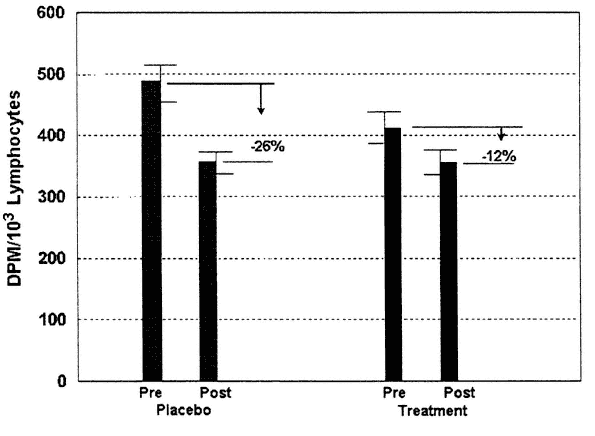
FIGURE 5-17
Peripheral blood lymphocyte proliferation during the antioxidant supplementation study with the Special Forces Assessment and Selection Course.
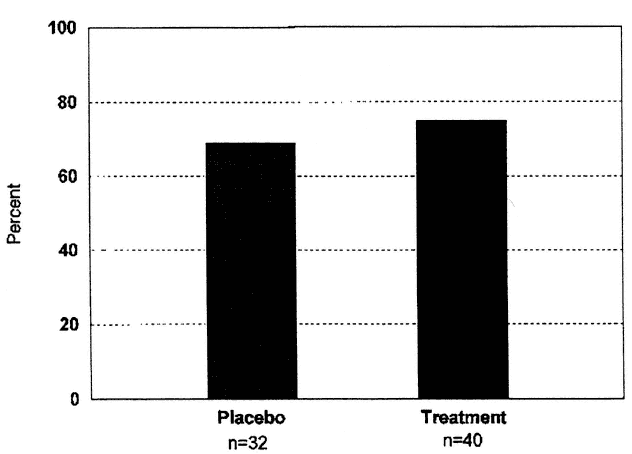
FIGURE 5-18
Delayed-type hypersensitivity response to tetanus toxoid during antioxidant supplementation study with the Special Forces Assessment and Selection Course.
was to provide the RTB with data to support the changes that had been made in the training protocol to ensure training safety. The secondary objective was to provide the necessary physiological and immunological background for future intervention studies.
Recently, a Memorandum of Agreement (MOA) has been developed that formalizes the working relationship between the SFAS and the MND. The salient features of this MOA include ready access to research volunteers and facilities support at Camp Mackall, North Carolina. Because of the MOA, planning and conducting field research is now accomplished at the company level. Building space and facilities support have been provided allowing for prepositioning laboratory equipment and supplies at the field site. These developments allow research to be conducted at significant monetary savings and with quick turnaround for planning and conducting the research and data analysis.
With this foundation of administrative support, the techniques can be refined to assess immunological responses at the cellular, molecular, and genetic levels. Techniques necessary to support this effort are currently being developed through the CRDA with ROSS and collaboration with academia.
In addition to collaboration with U.S. Army Special Operations units, areas for collaboration with Special Operations units in other countries should be explored. Lewis et al. (1991) have reported on changes in physiological and immunological parameters in Royal Marines. A review of this report shows both similarities and differences when compared with work from this laboratory over the past 4 years.
This research has a high degree of military relevance. While infection and disease susceptibility have always been a major concern to military activities, it is especially important now, considering the high rate of deployment of Army soldiers over the past 8 years. Prophylactic measures such as proper personal hygiene, vaccines, and antibiotics continue to play important roles. However, these measures alone may not always be enough. Antibiotic-resistant strains of bacteria are becoming more and more prevalent.
Although the immediate application of the findings from these studies is with Special Operations units, the implications of the research go far beyond this select army population. Nutritional strategies that will sustain host defense mechanisms during the stress of Special Operations training have important applications to sustaining the total force. Furthermore, this unique model may provide important insights into the cellular and molecular mechanisms involved in the complex interaction between nutrition and immune responses.
References
Consolazio, C.F., L.O. Matoush, R.A. Nelson, R.S. Harding, and J.E. Canham. 1966. Nutritional survey: Ranger Department, Fort Benning, Georgia. Laboratory Report
No. 291. Denver, Colo.: U.S. Army Medical Research and Nutrition Laboratory, Fitzimons General Hospital.
Johnson, H.L., H.J. Krzywicki, J.E. Canham, J.H. Skala, T.A. Daws, R.A. Nelson, C.F. Consolazio, and P.P. Waring. 1976. Evaluation of calorie requirements for Ranger training at Fort Benning, Georgia. Technical Report No. 34. Presidio of San Francisco, Calif.: Letterman Army Institute of Research.
Lewis, D., M. Simmons, R. Pethybridge et al. 1991. The effect of training stress on the immune system in Royal Marine recruits. Alverstoke, GOSPORT, Hampshire : Institute of Naval Medicine.
Montain, S.J., R.L. Shippee, W.J. Tharion, and T.R. Kramer. 1995. Carbohydrate-electrolyte solution during military training: Effects of physical performance, mood state and immune function. Technical Report No. T95-13, AD-A297 258. Natick, Mass.: U.S. Army Research Institute of Environmental Medicine.
Moore, R.J., K.E. Friedl, T.R. Kramer, L.E. Martinez-Lopez, R.W. Hoyt, R.E. Tulley, J.P. DeLany, E.W. Askew, and J.A. Vogel. 1992. Changes in soldier nutritional status and immune function during the Ranger training course. Technical Report No. T13-92, AD-A257 437. Natick, Mass.: U.S. Army Research Institute of Environmental Medicine.
Palinkas, L.A. 1988. Disease and non-battle injuries among U.S. Marines in Vietnam. Milit. Med. 153:150-155.
Seay, W.J. 1995. Deployment medicine: Emporiatrics military style. Army Med. Dept. J. July/August:2-9.
Souba, W.W. 1992. Glutamine, Physiology, Biochemistry, and Nutrition in Critical Illness. Austin, Tx.: R.G. Landers Company.
Young, A., and R.L. Shippee. 1995. The impact of Ranger training on physiological responses and responses to thermoregulatory tolerance to cold. Human Research Protocol No. MND95009-AP027-H028, November 7 . Natick, Mass.: U.S. Army Research Institute of Environmental Medicine.
Discussion
ROBERT NESHEIM: Thank you, LTC Shippee. That was interesting to see what has progressed since the last time the Committee had a chance to review the Ranger studies.
GAIL BUTTERFIELD: In the study in which you fed [supplemental] carbohydrates, did you actually test for antigens?
RONALD SHIPPEE: If I could go back, I would do a lot of things knowing what I know now. But I wish. . . . That opportunity is open. The experiment was done in Dahlonega, Georgia, which is the mountain phase of Ranger. That is a very interesting training site, and that opportunity is open. The Ranger Academy is very open to using their cadre as a test model. I think it has been an underutilized model.
GAIL BUTTERFIELD: I have one other question. Is the rate of weight loss that was seen in the Special Forces over 3 weeks about the same as you find in your early work on your Rangers?
RONALD SHIPPEE: Yes.
GAIL BUTTERFIELD: But what is troubling to me is that it looks like the Special Forces [Assessment School trainees] are not doing as well as the Rangers are doing now, and that disturbs me.
RONALD SHIPPEE: It disturbs me, too.
ROBERT NESHEIM: A question over here.
RONALD SHIPPEE: I would like to comment first. Medical attention is much better [for SFAS trainees] because they don't spend as much time away from the base camp. Another significant observation for the Rangers, based on our data, too, is that even before the incident in February, is medical personnel have managed to travel out in the woods with these soldiers. So, there is more medical attention.
SUSANNA CUNNINGHAM-RUNDLES: I have a comment with respect to what you said about B-cells responding to PHA [phytohemagglutinin] activation. Up to 15 percent of peripheral blood mononuclear cells, which are B-cells, will respond to the change. Where you have stress with the T-cells, I think it is not surprising, but it is interesting. I also wonder what was your incubation period, 4 hours?
RONALD SHIPPEE: Yes, 4 hours. We were hoping, as Becton Dickinson has said, that this would be a replacement for PHA 3-d culture, but that is not quite working out right.
SUSANNA CUNNINGHAM-RUNDLES: I know. It is not so easy.
RONALD SHIPPEE: Yes, I thought I had found a good alternative for the 3-d culture method.
SUSANNA CUNNINGHAM-RUNDLES: I don't think they have done the number of studies that you have.
RONALD SHIPPEE: No. We attended the users' meeting in New England and discussed this with representatives from Becton Dickenson.
SUSANNA CUNNINGHAM-RUNDLES: Right.
DARSHAN KELLEY: In your Ranger and SFAS experience, there is calorie deficit, and there is physical exertion. We have done studies with overweight women with none of these things except calorie deprivation as a factor. Twelve to 15 weeks of 50 percent calorie restriction would cause a 25 to 40 percent increase in MPH the number of NK cells, the PHA-Con-A stimulation. There are, also, decreases in the serum and in the blood.
RONALD SHIPPEE: I am not denying that caloric deprivation isn't a component, but again I think this is where we must discuss the military relevance of what we are doing, there is going to be some caloric deprivation in a combat situation.
So, the question is, can single nutrients and nutritional strategies enhance or keep the immune response up? There is something else you need to consider in a military environment, and I learned this working at the Burn Center.
If you look at predictors of recovery from burns, it is age and weight, when they come into the burn unit, and another one is nutritional status.
So, in military soldiers you have got to think about whether we can give them a good immune system prior to getting wounded, and will that help the surgeon and speed recovery?
So, I am not denying that calories are a major component, but in our situation it may be practical for us to see if we can sustain immune responses with a single nutrient or multinutrient under a caloric restricted situation.
ROBERT NESHEIM: I think we will have to take just one more question and move on because we will have some time this afternoon for further discussion.
SIMIN NIKBIN MEYDANI: You saw a 10 percent response with the skin test. Was there a difference in the soldiers' prior exposure to tetanus, as far as isolation, when they were vaccinated?
RONALD SHIPPEE: I don't have access to that information. You would suspect in that age military population, they have probably had a booster shot within the last 4 or 5 years.
Now, I am interested in the way you present your data, and it has come up here before. You take the delayed-hypersensitivity skin test, and you will probably talk about this, and you present a cumulative value, right? I have not done that because I don't see much reaction to the other antigens, and I am starting to wonder whether maybe that in itself is significant. So, I always show the diphtheria and tetanus because I don't have any other reactions, and maybe that is the overall anergy that we are seeing.
ROBERT NESHEIM: Thank you very much. I think we have to move on. The committee will be dealing with this, and we will have some opportunities for further discussion later this afternoon.


































